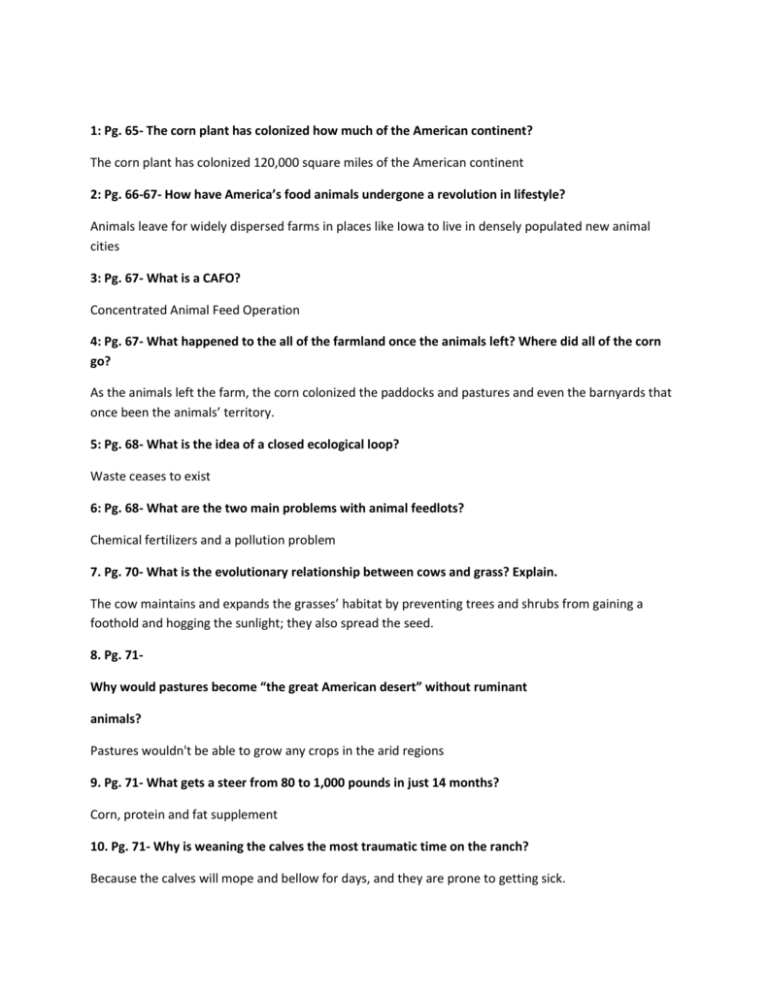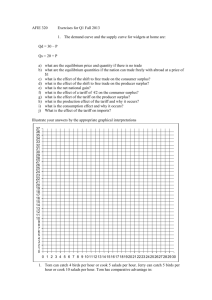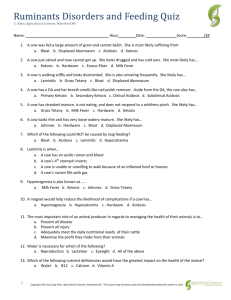File
advertisement

1: Pg. 65- The corn plant has colonized how much of the American continent? The corn plant has colonized 120,000 square miles of the American continent 2: Pg. 66-67- How have America’s food animals undergone a revolution in lifestyle? Animals leave for widely dispersed farms in places like Iowa to live in densely populated new animal cities 3: Pg. 67- What is a CAFO? Concentrated Animal Feed Operation 4: Pg. 67- What happened to the all of the farmland once the animals left? Where did all of the corn go? As the animals left the farm, the corn colonized the paddocks and pastures and even the barnyards that once been the animals’ territory. 5: Pg. 68- What is the idea of a closed ecological loop? Waste ceases to exist 6: Pg. 68- What are the two main problems with animal feedlots? Chemical fertilizers and a pollution problem 7. Pg. 70- What is the evolutionary relationship between cows and grass? Explain. The cow maintains and expands the grasses’ habitat by preventing trees and shrubs from gaining a foothold and hogging the sunlight; they also spread the seed. 8. Pg. 71Why would pastures become “the great American desert” without ruminant animals? Pastures wouldn't be able to grow any crops in the arid regions 9. Pg. 71- What gets a steer from 80 to 1,000 pounds in just 14 months? Corn, protein and fat supplement 10. Pg. 71- Why is weaning the calves the most traumatic time on the ranch? Because the calves will mope and bellow for days, and they are prone to getting sick. 11. Pg. 73- What is the only reason contemporary animal cities aren’t as plague -ridden or Pestilential as their medieval human counterparts? Modern antibiotic 12. Pg. 73“So if the modern CAFO is a city built upon commodity corn, it is a city afloat on an Invisible sea of Petroleum” 13. Pg. 75- Why is corn fed meat less healthy for us? Because it contains more saturated fat and less omega-3 fatty acids than grass fed animals 14. Pg. 75What practice of feeding cows led to the “Mad Cow Disease”? Feeding cow parts to cows 15. Pg. 77- How are we choosing which cows we want to select to breed? By their ability to eat large quantities of corn and efficiently convert it to protein without getting too sick. 16. Pg. 77- What is the #1 ailment found with cows fed on corn? Why- explain. Bloat, when a diet contains too much starch and too little roughage rumination all but stops, and a layer of foamy slime forms in the rumen that can trap the gas. Which causes to a series disease. 17. Pg. 78- What is acidosis and what does it cause in the cow? Causes the cow to go off their feed, pant and salivate excessively and eat dirt 18. Pg. 78- What percentage of cows at slaughterhouses is found to have abscessed livers? Between 15 and 30 percent 19. Pg. 78- What is the leading causes of the evolution of antibiotic resistant superbugs? Antibiotics that end up in animal food 20. Pg. 79- What chemicals are found in the “manure lagoon” on CAFO’s? Nitrogen, phosphorus, heavy metals, hormone residue and persistent chemicals 21. Pg. 80- How many pounds of corn does it take to make 4 pounds of beef? What is the ratio? For chicken? 32 pounds of corn to make 4 pounds of beef. The ratio for chicken is 2:1, or 8:4. 22. Pg. 82- How has the new strain of E. coli (O157: H7) evolved and what is the problem with it? How can this problem be fixed? E. coli has a new acidic-resistance; the problem is that they’ll produce a toxin that destroys human kidneys. By acidifying the rumen with corn. 23. Pg. 82- How is the costs associated with the CAFO’s externalized? Explain. Externalized based on environmental costs. Spraying fertilizer, pesticides and using water to grow the corn and if these externalized costs are included, corn would be very expensive. 24. Pg. 83- Discuss the path of corn backward from the corn fields and discuss the implications. It starts in the middle of a 125k monoculture, then along with the fertilizer runoff it would go all the way to the gulf of mexico. And then it grows corn all the way to the oil fields of the Persian gulf. 25. Pg. 83- How much of America’s petroleum usage goes to producing and transporting our food? 1/5 26. Pg. 84- If a cow reaches his full weight- how much “oil” will he have consumed in lifetime? 35 gallons of oil 27. Pg. 84- “You are what you eat” is a truism hard to argue with, and yet it is, as a visit to a feedlot suggests, incomplete, for you are what you eat eats, too. And what we are, or have become, is not just meat but number 2 corns and oil- Discuss. Because if we are what we eat or what we eat eats, corn is consumed by animals more than half percentage, and oil is used to grow the plants and crops we eat if not we directly consume corn in a lot of daily products so if we are indeed what we eat we are corns and oil.







